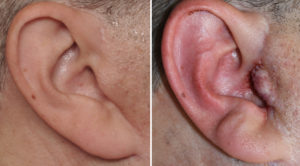The facelift procedure, no matter how it is done and its extent, involves an incision along the front of the ear. Even the most limited facelift needs a preauricular incision. Once debated whether the preauricular incision should be in front of (pretragal) or behind the tragus (retrotragal), that has long given way to the retrotragal technique in women.
In men, however, the incisional debate remains due to the presence of beard skin. Is it better to place the incision in the skin crease in front of the ear and risk not pulling beard skin up onto the tragus and completely effacing the natural non-hair bearing skin between the ear and the beard line? Or is it better to keep the scar behind the tragus (hidden) but risk having beard growth up on the ear…or at least have the beard line pulled back right up against the ear.
Most facelift surgeons that I know, including myself, prefer the retrotragal approach for both female and male facelifts. Preventing hair growth on the tragus can be done during closure by removing all hair follicles seen under the dermis.
But another minor adverse aesthetic sequelae can be seen from a retrotragal facelift approach which is loss of the tragal-facial break. This is the natural demarcation that exists between the face and the normal angular protrusion of the tragus. This natural demarcation can be lost due to deformity of the tragus cartilage, thicker skin being pulled from the face back onto the tragus where thinner skin normally resides or a combination of both. When this is lost it can appear that the face sweeps right back into the ear canal.

The telltale signs of having had a facelift are ear shape alterations and visible scarring. While changes to the tragal cartilage shape may seem minor, it disrupts the normal facial landmarks. Such changes can be improved by reshaping of the cartilage and skin thickness.
Dr. Barry Eppley
Indianapolis, Indiana


